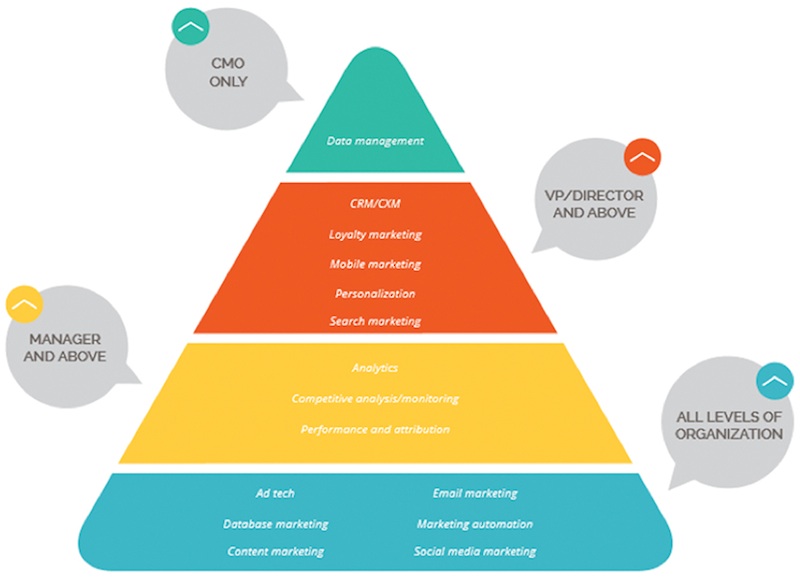|
|
According to Google research, a typical B2B buyer now conducts an average of 12 web searches before engaging with a specific brand’s website. And then after that initial digital interaction, Walker Sands Communications client data shows that a prospect has seven to 15 additional touchpoints with a brand before turning into a qualified lead. As the traditional linear sales funnel turns into a complicated pretzel of interconnected channels, it becomes critical for marketers to understand this new buyer journey and stay in front of buyers over the course of a lengthy sales cycle.
|
|
A new study from Walker Sands that surveyed more than 300 marketing technology decision-makers finds that the B2B buyer journey is only increasing in complexity. For example, technology buyers have distinct needs during each phase of the buyer journey, which means B2B marketers must interact with them in different ways as they discover, research and purchase solutions. And it’s no longer just the C-suite making decisions about new technology, so marketers must understand how buyers and influencers throughout the organization make decisions, which differs depending on variables like title and company size.
The study shows why B2B marketers can no longer rely on a handful of dominant and isolated marketing channels to reach prospects. To connect with buyers today, brands instead need a marketing strategy that gets earned, owned and paid media working together in harmony to ensure multiple points of interaction and conversion. Here’s a look at some of the findings from the Walker Sands study that marketers can use to map out the new B2B customer buying journey.
|
The Martech Decision-Making Hierarchy |
Discovery process
According to the study, 44% of businesses begin a search for new marketing technology when they recognize a need, and only 6% do so when they hear about a new piece of technology. In other words, B2B buyers aren’t going to consider making a new purchase unless they actually have a problem that can only be fixed with new technology. Simply becoming aware of a new technology brand will not motivate them to change the status quo, which means marketers need to focus on creating a need that speaks to buyer pain points.
Additionally, most marketers first learn about new marketing technology from peers, news publications or search engine results. Only 5% learn about new tools from sales representatives. So even if an organization has a need for new technology, decision-makers are going to be conducting their own research to learn about their options before contacting a vendor. This makes it critical for brands to be visible as buyers independently search for possible solutions, relying on tactics like media relations, search engine optimization and word-of-mouth marketing to get in front of prospects during the discovery phase.
Path to purchase
Once decision-makers discover new technology, most will conduct their own research to determine if the solution is right for their organization before they ever contact a sales representative. In fact, the Walker Sands study finds that 65% of marketing technology buyers are at least halfway to a decision before they contact the vendor. Most are reaching this decision by consuming either branded or third-party content across various channels. Specifically, the report shows that product demos, case studies and online reviews are the top three most influential types of content for marketing technology buyers.
To really stand out to business buyers at this research stage, quality content is key. Make sure relevant pieces of content are easy for buyers to find and consume, and that they clearly differentiate your solution (or your client) from competitors. Additionally, the messaging across all channels — whether it’s earned PR placements or owned branded content — must be consistent and tell a clear story. Most business buyers will not move to make a purchase if they’re not convinced with what they find during the research process.
Beyond the C-suite
To make this process even more complicated, most business organizations involve multiple individuals within decision-making processes, and all of these individuals have competing priorities. The Walker Sands study finds that almost two-thirds of marketers have led the decision-making process for at least one marketing technology purchase in the past three years, including more than half of entry-level marketers. And more than two-thirds of marketers say they are given the opportunity to provide input into the tech buying decisions that they use in their jobs.
Ultimately, B2B technology marketers need to appeal to as many individuals within an organization as they can. Learn about the prospect and how each level of the organization may find your tool useful. Maybe the C-suite has a vested interest in integration with other current platforms, while lower-level employees are more concerned about ease of use. Regardless of the selling points that your technology offers, make sure that your marketing and PR content focuses on how it appeals to everyone within an organization — not just the top executives.
By understanding how B2B prospects make purchase decisions throughout the new buyer journey, brands and agencies can develop coordinated PR and marketing strategies that ensure their brands are visible during every step of the decision-making process. To find out more, download the Walker Sands State of Marketing Technology 2016 report at walkersands.com/new-martech-buyer-journey.
* * *
Dave Parro is Partner at Walker Sands Communications.





 Laura Anderson, who rose to VP/GM of global communications and events in a nearly 20 year stint at Intel, will take on the Americas technology chair at Burson following the completion of the BCW and H+K merger on July 1.
Laura Anderson, who rose to VP/GM of global communications and events in a nearly 20 year stint at Intel, will take on the Americas technology chair at Burson following the completion of the BCW and H+K merger on July 1. WE Communications has partnered with ROKK Solutions to form the WE ROKK AI service.
WE Communications has partnered with ROKK Solutions to form the WE ROKK AI service. In the dynamic world of modern business, effective communication is a pivotal tool for success across various industries. At Communications Strategy Group (CSG®), our expertise in embracing innovation in communication extends beyond traditional marketing strategies, paving the way for transformative industry-specific solutions.
In the dynamic world of modern business, effective communication is a pivotal tool for success across various industries. At Communications Strategy Group (CSG®), our expertise in embracing innovation in communication extends beyond traditional marketing strategies, paving the way for transformative industry-specific solutions. There are two types of tech PR professionals. Which one are you? And are C-suite executives making that decision for you?
There are two types of tech PR professionals. Which one are you? And are C-suite executives making that decision for you? While there’s an impulse to grab reporters’ attention with the newest industry-transforming tech product or service, a back-to-basics approach focused on telling the right stories to the right people is a far more successful way to ensure your technology campaign breaks through the clutter of today’s crowded tech landscape.
While there’s an impulse to grab reporters’ attention with the newest industry-transforming tech product or service, a back-to-basics approach focused on telling the right stories to the right people is a far more successful way to ensure your technology campaign breaks through the clutter of today’s crowded tech landscape.


 Have a comment? Send it to
Have a comment? Send it to 
No comments have been submitted for this story yet.